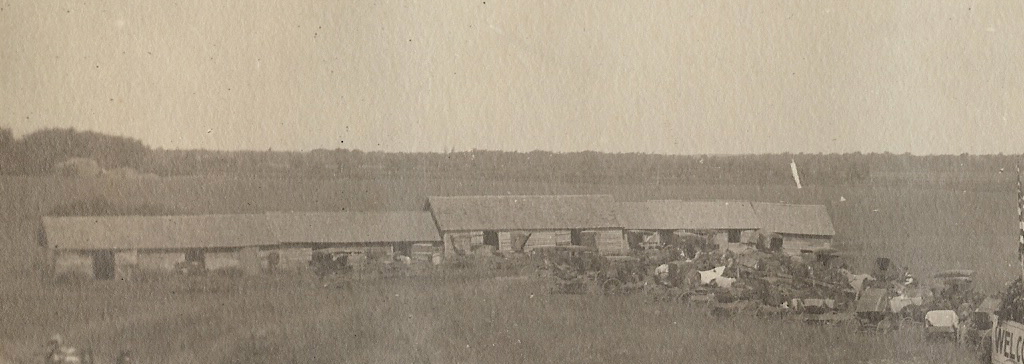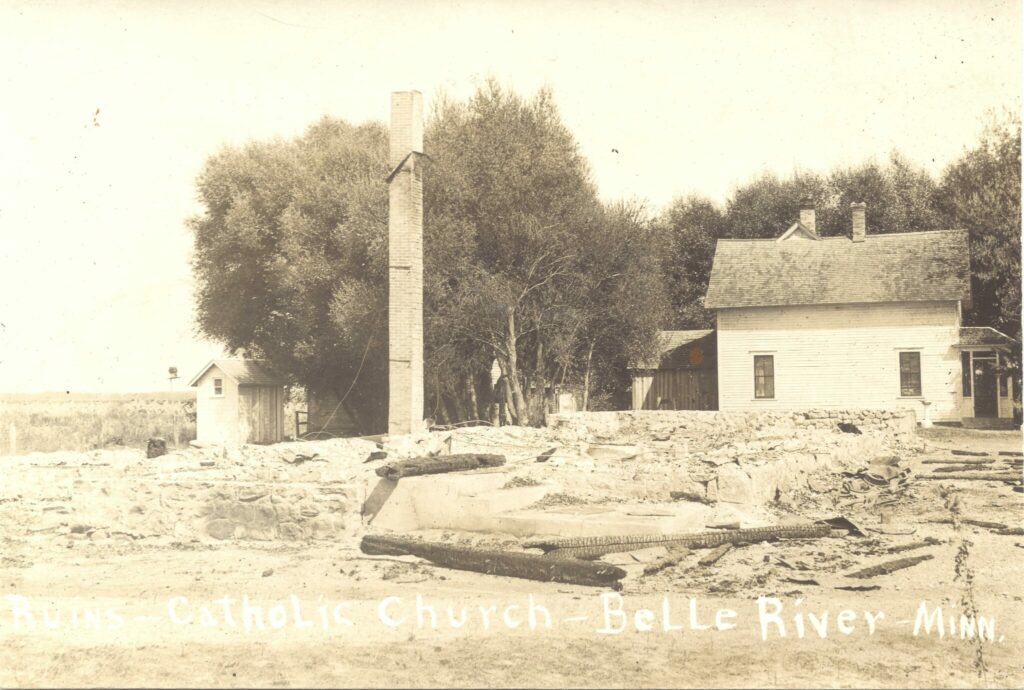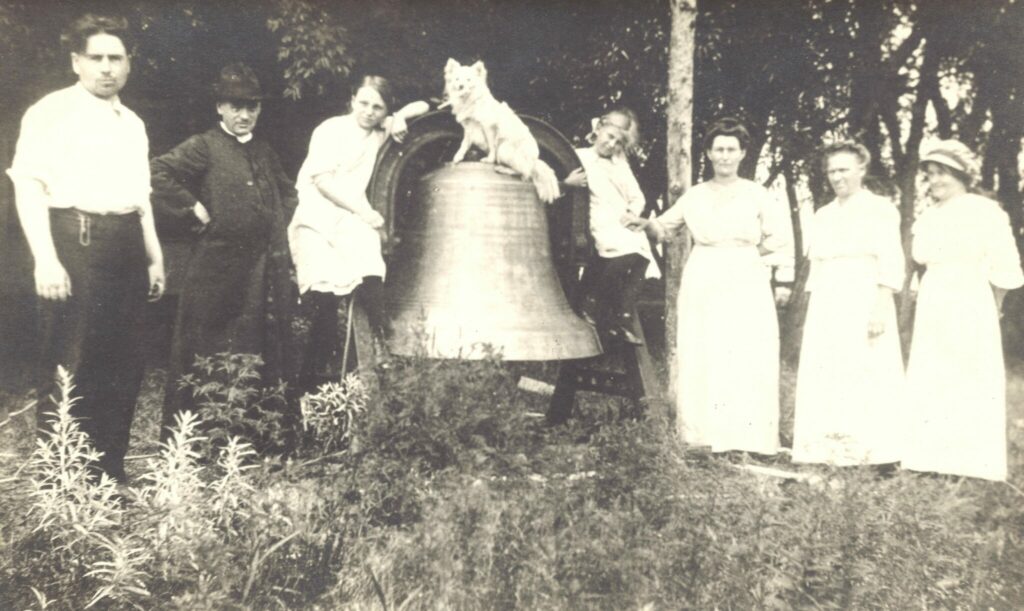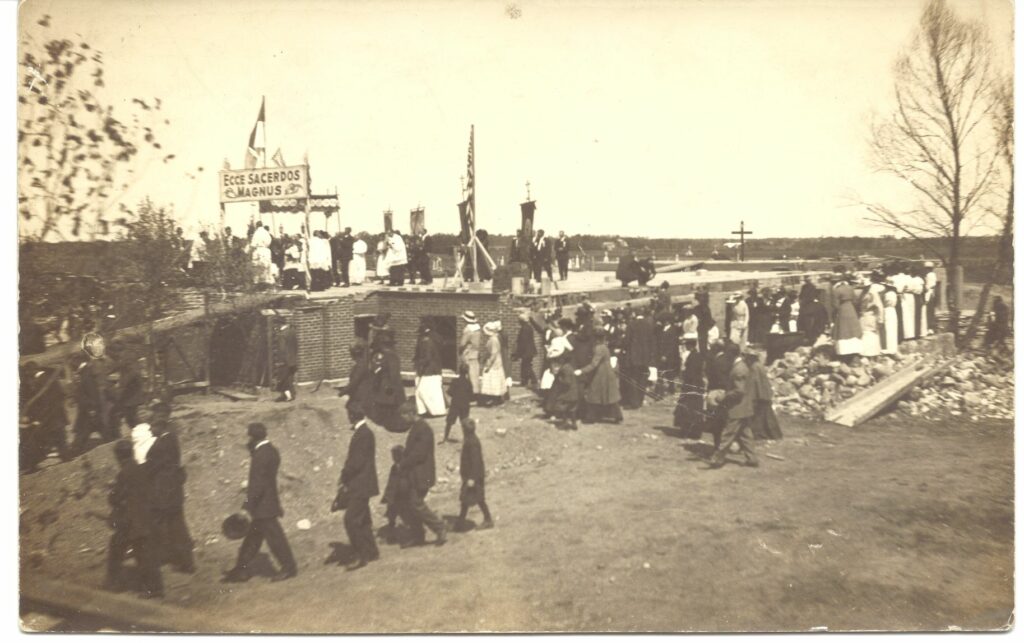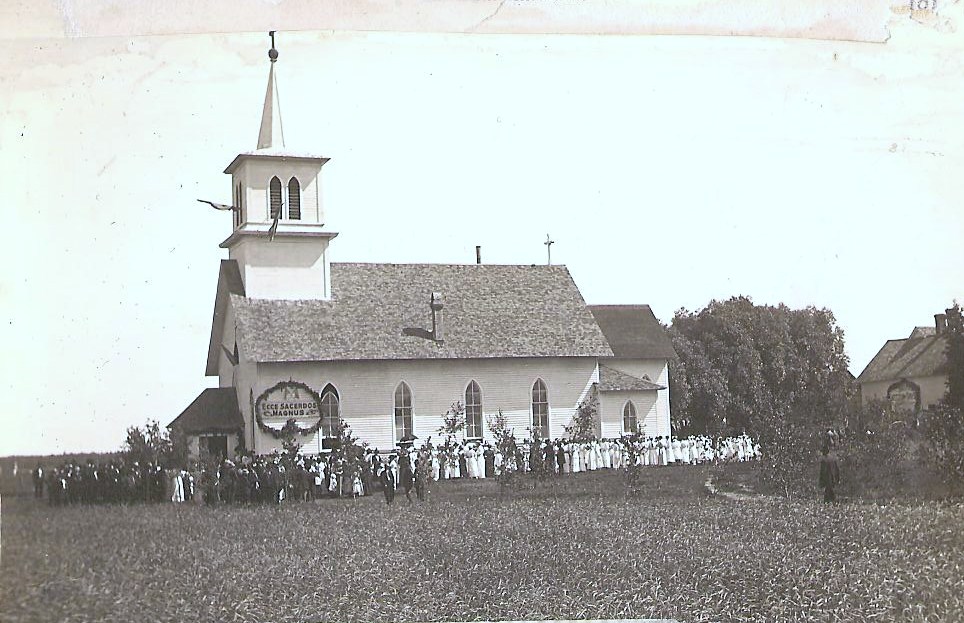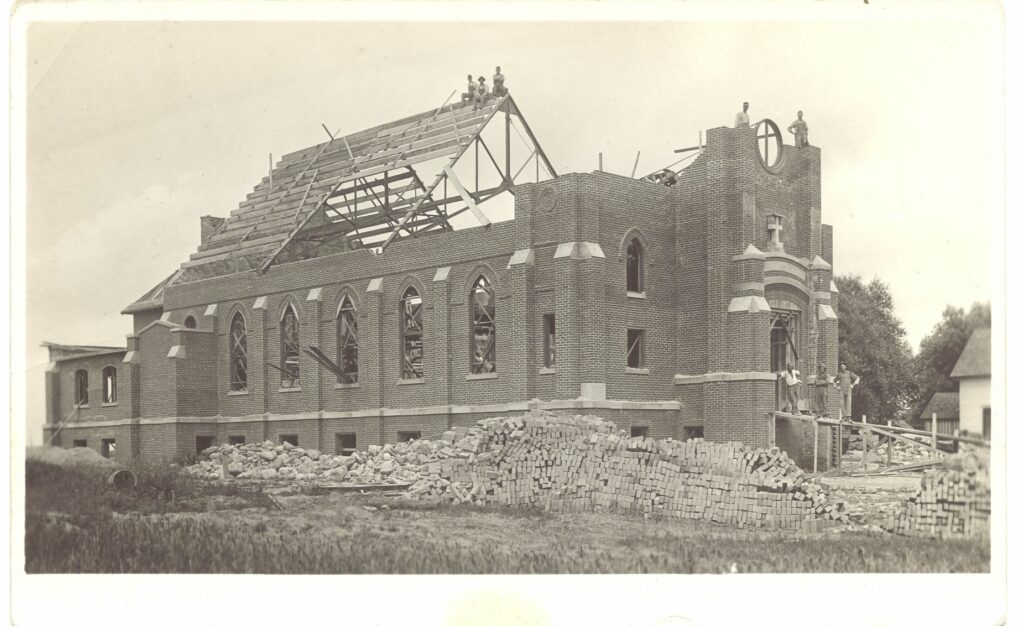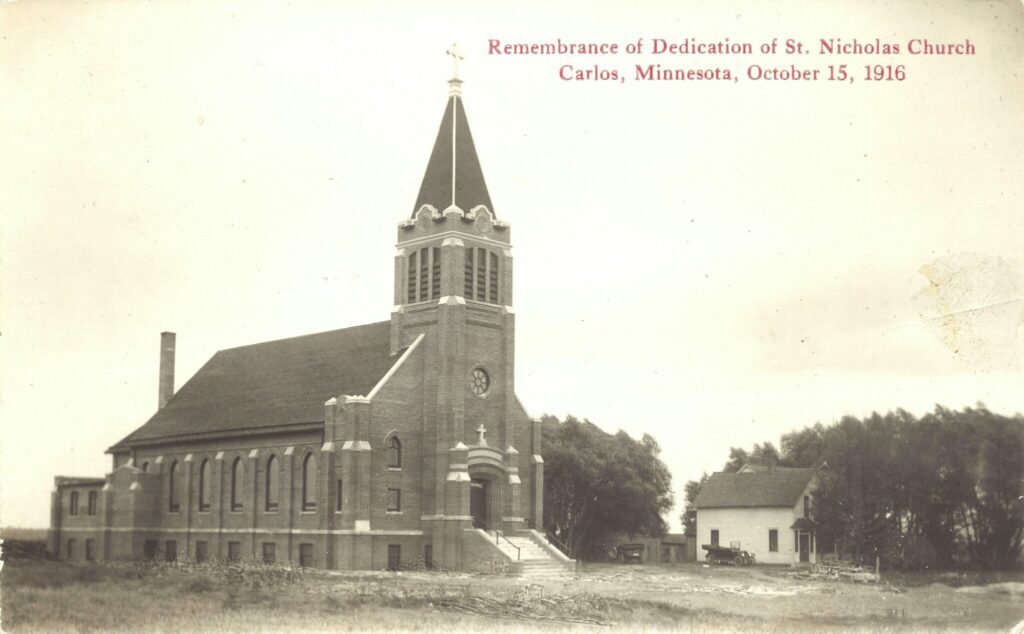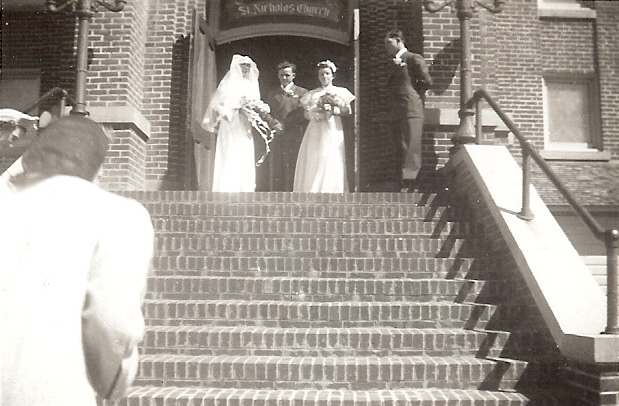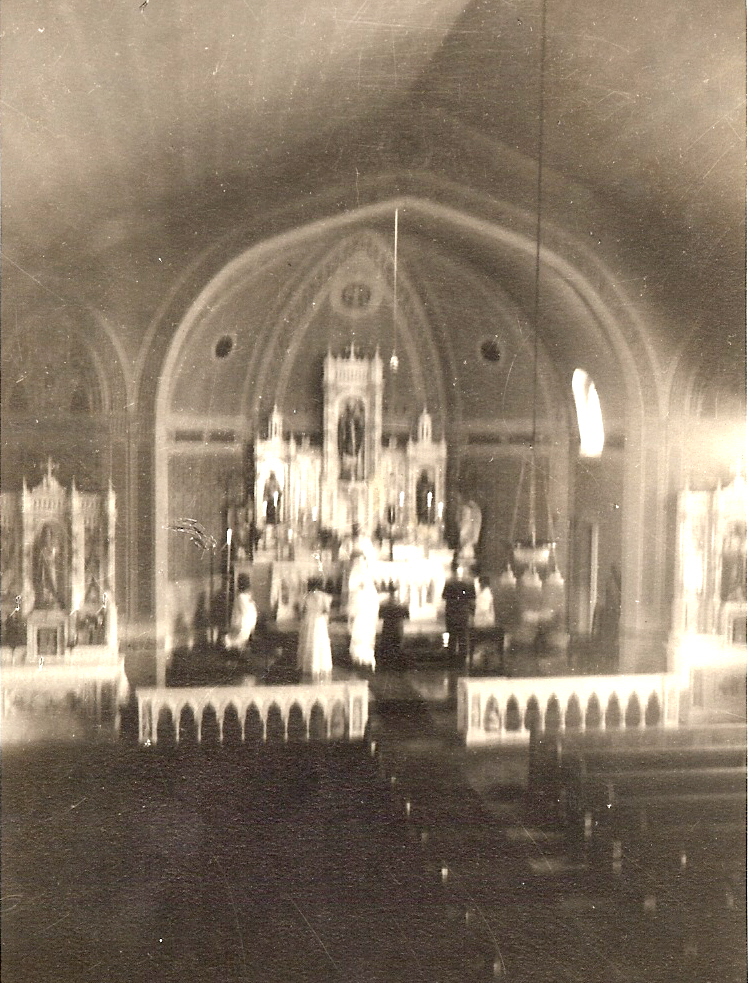Mission
Our mission is to build God's Church across generations by living the Eucharist.
Our History
History – through 1970
Local Historical Background
Compiled and written by:
Joseph Stoetzel & Father Braun
(From the 1970 Centennial Directory)
It is not possible to adequately describe the establishment of the older Missions and churches without a tribute to the zeal of the first Missionaries who served both the Indians and the European settlers of this area. We begin our narrative with a short history of their activities as well as those of the Benedictine Fathers of St. John’s Abbey, Collegeville, Minnesota, who served the Parish of St. Nicholas as a mission until the Diocese of St. Cloud was established in the year 1889. We should be deeply grateful for the efforts of these pioneer priests, for without their religious zeal, our parish might not have survived.
Father Francis Pierz came to Minnesota at the request of Bishop Joseph Cretin of St. Paul, whose Vicariate at that time included the entire region known as the Dakota Territory, from the Wisconsin boundary line, north to the Canadian border, and all the lands east of the Missouri River. Father Pierz arrived in St. Paul in May of 1852 after having worked among the Ottawa and Ojibway (later called Chippewa) Indians in Northern Wisconsin and had learned their language. While working among them for nearly fourteen years, going as far north as Grand Portage and Sault St. Marie in the north-eastern point of Minnesota, he arrived west of the Mississippi River with Bishop Cretin in late May of 1852, shortly after the Minnesota territory had been established by Act of Congress, and the are opened for settlement. After some Military Reservations had been established west of the Mississippi River, he was assigned as Director of all Indian Missions of this same area as well as of all northern Minnesota. Having established the first permanent Mission Headquarters at Crow Wing near Fort Ripley (a flourishing Fur trading post), he started another mission at Belle Prairie, about 15 miles south, and at Sauk Rapids in 1853. Father Pierz offered the first Mass in St. Cloud in the same year, under the protection of the trees near where the St. Cloud Children’s Home now stands. In 1854 he established the St. Mary’s Parish in ST. Cloud which is now known as the Cathedral Parish of the Diocese of St. Cloud. While at Crow Wing he visited Long Prairie, where an Indian School had been established by another Missionary, Father Vivaldi, for some Winnebago Indians. These had moved into Chippewa territory from the south after southern Minnesota had been opened for settlement. The Chippewas resented this intrusion and were on the warpath. After some of the trading posts and part of the mission had been destroyed or burned, the Winnebagos left for points farther west and Father Pierz talked the Chippewas out of further pursuit and bloodshed. The Long Prairie Mission was abandoned for some time and re-established later. After starting other Missions along the Sauk River westward, mostly for white settlers, he called on Bishop Cretin to appeal for help to a Benedictine Abbey in Latrobe, Pennsylvania, to serve the parishes already established, and went back to his missions. After the arrival of a small group of Benedictines by boat down the Ohio and up the Mississippi to St. Paul in 1856, Bishop Cretin accompanied them by stage coach to Sauk Rapids. Upon their arrival in St. Cloud, he urged them to start a school and also a Monastery, if at all possible, as Catholic immigrants were coming west at a rapidly increasing rate from various European countries, and priests could not be provided for them all in any other way. Later that year Abbot Wimmer, O. S. B., of St. Vincent’s Abbey, Latrobe, Pa., paid a surprise visit to the group, bringing along with him a small number of priests. After some consultation, it was agreed to try to acquire more land further west to establish a Monastery. In 1857 the Minnesota Legislature gave a Land Grant Charter to the Benedictines to establish a school of higher education, and soon after the Order of St. Benedict started St. John’s Abbey which later became St. John’s University. Abbot Rupert Seidenbusch was appointed Vicar Apostolic of Northern Minnesota in 1876 by Bishop Grace of St. Paul.
Father Pierz meanwhile, had established more missions to the north and west and it soon became apparent to him that he could not keep up his strenuous travels alone, so he asked Bishop Grace for permission to return to his native Slovenia to recruit more workers for his missionary work. He was already seventy-five years of age in 1863, and had spent about fourteen years among the Ottawa and Chippewa tribes as far north as the north shores of Lake Superior. When he arrived back in April of 1864, he brought with him one priest, Father Buh, and twelve clerics and students, among them some soon to be ordained, all Slovenians. An Austrian Mission Association provided 3,000 guilders for the Ocean passage of this group. Among these were Father Ignatius Tomazin, and Father James Trobec, who later became the Bishop of St. Cloud, from whom many now living in the parish of St. Nicholas received the Sacrament of Confirmation. Father Tomazin soon joined Father Pierz in his journeys through this area and is reported to have offered the first Mass in this area at the home of Frank Quinn, Sr., about the year 1870. Also Mass was offered several times at the home of Nicholas Botzet, Sr., and Music was furnished by Catherine Botzet on a portable organ.
The Belle River township was organized March 8, 1870 at a meeting at the home of Mathias Klein and was at that time named Riverdale. Temporary Officers were nominated and it was agreed they hold the first Regional meeting at the home of Martin Crowson. The Regular Officers were elected April 12, 1870, prior to the General election on November 8th. Appointed were the following: George B. Craig, Clerk, E. J. Henry, Assessor, Nicholas Brown, Treasurer, N. L. Reuter, and J. L. Griffin, Supervisors, O. B. Cooley, Chairman, N. L. Barnes, Justice of the Peace, and Henry Botzet, Constable. It was agreed at this meeting that the name of Riverdale be changed to Belle River, a change that was approved by unanimous consent by the Officers of the Township and also by the County Board. Douglas County was organized only four years earlier in 1866. Government troops left Alexandria the same year, having been stationed there since the Indian uprising in 1862. A stockade had been built in 1862 and stood for many years thereafter.
It was quite well known that Father Pierz offered Mass at a number of homes in this area wherever a small group came together. When these groups became larger he advised them to work together to build a church so all could worship together. He had already established a mission parish in Millerville in 1867, about 20 miles west of Belle River, three years before Father Tomazin offered Mass at the home of Frank Quinn, and suggested in the year 1870 that the people of this community do the same. Soon after this a group of Catholics met again at the Frank Quinn home where township meetings were also held during these years, and agreed to build a church of logs on land donated by Frank Quinn and John Clousen. Each gave ten acres on either side of the 1st quarter line of the S/W 1/4 Section 9 where their lands joined. The log church was erected soon afterward by a community effort and was dedicated in 1871 by Archbishop Thomas L. Grace of St. Paul. On the same occasion a number of the children of the parish were confirmed. Later in the same year a renowned Jesuit Missionary, Father Xavier Weninger, conducted a week-long Mission here as well as at Millerville. Father Ignatius Tomazin visited the parish and conducted services at infrequent intervals until August of 1873. Following Father Tomazin, the Pastor of Long Prairie, Father John Schenk attended to Belle River as a mission until 1883. One living member of the parish, Nicholas Hintzen, claims to have been baptized in the original log church.
The Belle River Parish area at this time included all of Carlos, Miltona, and Spruce Hill townships, and parts of several adjoining townships of western Todd County. Most of the early settlers of the Osakis townships also attended the mission of Belle River before St. John’s Abbey established a Priory or Brotherhood Farm, as it was called, in 1882, in the Osakis area. Since the Priests came from this Priory to serve the missions of this area only at infrequent intervals, this most likely accounted for the lax attendance at Mass and religious service in later years. The residential and monastic quarters of the St. Alexius Priory consisted of a large brick building of three stories and many chimneys and was completed in 1884. By this time quite a number of families south of Belle River as well as from Osakis were attending services there and a frame church was soon built to accommodate them. This church was later moved to West Union village in about the year 1899. About 1900 a mission parish had been established in Osakis. Early settlers from this area traded their oxen for horses at the Brotherhood Farm. Since religious services were conducted at Belle River only about once each month, a few sons and daughters of the early settlers traveled by wagon or on foot to the Brotherhood Farm to be married there.
In 1883 Father Placid Weingerter, O. S. B. of St. John’s Abbey was assigned to the Belle River Parish, who immediately planned for the construction of a frame church since the parish had grown larger than could be accommodated in the old log structure. The second church was built that same year by Contractors from Alexandria, Raiter and Spooner. The following year, in 1884, a small parish house was built by William Maher, John Collins, and Anton Schneiderhan, Sr., so that the Priests coming from St. John’s Abbey or from St. Alexius Priory, would be able to stay overnight, before a Resident Priest was assigned to the parish of St. Nicholas.
Benedictine Priests who served the mission here were Father Ildephonse Molitor, O. S. B., Father Alfred Meyer, O. S. B., Father Martin Schmitt, O. S. B., and Father Jerome Heider, O. S. B. None of these priests were regular Resident Pastors of the parish. In 1890 Father Ignatius Lager was appointed as the First Resident Pastor, who immediately planned for an addition to the parish house to be used as a parish school but served as a winter chapel instead. During this time a one week Mission was conducted by a Jesuit Priest, Father Peter Post. About the time Father Lager’s term as Pastor at Belle River expired, we find the following entry, taken from Parish files and Mission Chronicles in the St. John’s Abbey Archives: (quote) “The Diocese of St. Cloud entry for January, 1893 says: Belle River Church (St. Nicholas) has been closed and the priest removed by our (Bishop Zardetti’s) order. This punishment has been deserved by a people who perseveringly opposed our orders and made the existence of a Pastor imbearable” (end of quote). Evidnetally, the Reverend Bishop changed his mind a short time later, and int he summer of 1893 appointed Father Ignatius Tomazin as Resident Pastor of St. Nicholas Parish, who also served as the Pastor of Alexandria as a mission from 1895 to February of 1899.
After an extensive search of old legal records, private documents, individual family records, and interviews with descendants of early Catholic families, believed to have been here over a century ago, we submit these names. Although this list may contain a few errors or even omissions, we beg your forbearance. Following are some of the very early settlers of the Belle River are: Peter Beheng, Sr., Simon Steidl, Sr., Peter Henry, Sr., Stephen Miller, Michael Fitzgerald, John J. Henry, Charles Baumers, Nicholas Botzet, Sr., John Collins, Sr., John S. Miller, Sr., Henry Botzet, John Hagan, Sr., Caspar Pasch, Sr., Mathias Klein, Nicholas Reuter, Sr., Henry Geris, Sr., James Maher, Sr., John Hermes, Sr., Nicholas Brown, Sr., Frank Quinn, Sr., John Clausen, Anton Schneiderhan, Sr., Joseph Ritten, Sr., Adam Bock, Sr. Others who arrived in this area from 1870 to about 1883 were: Frank Feda, Sr., Leonard Hintzen, Sr., Martin Trisko, Sr., Henry Nabauer, Ludwig Zimmel, Sr., Theo, Fyten, Aloysius Pfeffer, John Dunn, James Maher, Wenzel Zimmel, Henry Trisko, John Petruik, Sr., Joseph Wolters, Stephen Illetchko, August Grundei, John Drexler, Andreas Schlosser, Sr., Frank Hoffman, Matt and Peter Rentges and the Bartens. After about 1888 other settlers were: Andrew Zimmel, Sr., Albert Zimmel and the families of Weisgram, Zimmermann, Allers, Peacock, Elsner, Weber, Juberian. Also among this group were Henry and Wencel Adensam, Joseph Trisko and Joseph (Sneider) Trisko. Some early settlers of the Osakis area were: Sylvester Hausen, Math Hausen, John Brouns, Sr., Leonard Kasemacher, Sr. Julius Jung, and families of Verlinden, Goldschmidt, Hendricks, Ritter, Kraemer, Fuchs and Konsak. Some settlers of Todd County and Oak Hill were: families of Sursleys, Collins Hentjes, Schuelers and Webers. Settlers of Spruce Hill township were Frank Pexa, Sr., Frank Barta, Sr., Frank Hainzel, Sr., Leopold Hainzl, Alex Zimmel, Frank Illestschko Wagner, Alvin Milligan and families of Janek, Mrnak, Sherik, Keslik and Bearoughs. Arthur and William Merrical built the first Flour Mill and Saw Mill in the area at what is known as Spruce Center. Early settlers of the Miltona area were Albert Starkey, Sr., John Kuhne, Sr., Mathias Fida, Sr., Leopold Fida and one Zimmel family.
Several religious vocations have originated from the St. Nicholas parish. They are: Sister Jovita, OSB, daughter of Mr. and Mrs. Frank Illetschko, and Sister M. Georgine, O. S. F., daughter of Mr. and Mrs. George Larson. Also Sister M. Agnes, OSF, and Sister M. Rita, OSF belonged to our parish and have gone to their eternal reward. Although several boys from the Belle River parish started pre-seminary training, not even one has followed in the footsteps of the twenty or more priests and missionaries who have served our parish these past 100 years.
Among those who served as organists in the St. Nicholas parish over the decades were Mary Ritten, Catherine Botzet, Josephine Geris, Mayme Schneiderhan, Annie Becker and Henry Stoetzel. Norma Hintzen, who served as organist for forty years was a recipient of the Bishop’s Medal for Meritorius service, as was also Rudolph Zimmerman, who was awarded the Bishop’s Medal while a patient of the Our Lady of Mercy Hospital in Alexandria. Mr. Zimmerman had served as Sacristan and Trustee for 33 years. At the present time, Carole Steidl, also a music teacher, is the organist for the parish, with the continuing assistance of Norma Hintzen. Serving at the present time as Officers of the Parish are: John Bock as Secretary and Joseph Stoetzel as Treasurer, who has also the distinction of having been a member of the parish choir for fifty years.
Let us recall that Railroad Services even from St. Paul did not reach St. Cloud until 1867 and Melrose until 1874. The first Passenger Train arrived in Alexandria on November 7, 1878 and one year later ran as far as Evansville. Before the railroad could bring in farm equipment to this area, most farm work was done by hand. For plowing, oxen were used. Seeding and cutting of grain was done by hand. Threshing was done by hand flailing. The Rueter family, Peter, Sr. and his brother Caspar, Sr., owned the first horse-powered threshing machine driven by four 2-hours teams turning a gear-driven apparatus. Even then it took a large crew of neighbors to cut the bundles, feed them into the machines, measure the grain with a wooden bushel measure and several men to pile away the straw. Some complained that the horses ate a big share of their oats crop before the threshing was even completed. Soon stationary steam engines came into common use for power and by the late 80’s and early 90’s steam traction engines, which could move and pull the threshing rigs, became the modern way of harvesting. In 1900, P. L. Muyres built a General Store at the crossroad west of the Church, which is still operated by one of his family, seventy years later. In about 1904 a creamery was built by John and Caspar Michaels, later operated as a co-operative until November 1965.
The early pioneers were ambitious and proud of what they owned and earned. Even before the railroad came, as early as 1852, there were stage routes from St. Paul to St. Cloud and by 1858 from St. Cloud to Fort Abercrombie on the Red River near Breckenridge. These hauled passengers and mail over the old Military Trail as well as supplies west and brought back furs on the return trip. Another Military Trail, then called the Old Otter Tail Road, ran northwesterly from west of Lake Osakis to Detroit Lakes and White Earth Indian Reservation. Stages also traveled this road and picked up and delivered mail just east of the Long Prairie River at the old Rueter homestead about two miles east of the present church. Our first mailing address was Belle River and stayed that until the Soo Line’s Winnipeg branch was built from Glenwood in 1903, when Carlos Village was established and became the Post Office for the area. The last Belle River P. O. was at the farm of J. C. Miller, about one mile east of the present church.
During the earlier years of Father Tomazin’s term as Resident Pastor, there was much displeasure and dissatisfaction about his rigid demands for compliance with certain rules he had established, which quite a number of parishioners resented. No doubt, the old Missionary, having spent around forty years among the newly converted and docile Catholic Indians, who minutely followed every rule, could not understand why people reacted as they did. The parishioners, a conglomeration of Irish, Germans Austrians, Hollanders, Czechoslovakian and even a few of French and Indian heritage, did not understand his ways. No doubt his intentions were the best, but to apply trivial and uncommon sanctions, such as forbidding the use of an organ and singing for a considerable length of time, only made people more resentful. An Irish lady is reported to have remarked how happy all were to here the organ and singing again on the occasion of her first Holy Communion. Even attendance at Mass and religious services decreased, which of course, also indicated that the faith and religion of the people was not very deep not to understand that the Mass and the Sacraments were of much greater importance than singing and the playing of the organ. Father Tomazin was assigned to the parish of Padua in July of 1907, after indeed a sad and distressing episode in our parish, both for the old Missionary as well as for the people. Before Father Tomazin left he brought the property title of the parish up-to-date and effected the legal ownership by the people of their church property. Title transfers had not been made to Bishop Marty who followed Bishop Zardetti, when the latter was appointed Archbishop of Bucharist. A few years later, when Bishop Zardetti died, the title fo the church property fell to his heirs. After considerable effort, by Father Tomazin, the Zaretti heirs, by Quit Claim Deed, transferred their rights of title to Bishop Trobec. He then incorporated the parish, with Bishop James Trobec, President, Rev. Msgr. Edward Nagle, V. G. as Vice President, Rev. Ignatius Tomazin, Chairman, Joseph Wolters, Secretary, and Charles Pasch, Treasurer.
Father Herman Klein became our Pastor about August 1, 1907 and again provided for a successful Mission by a Dominican Priest, Father Thuente. He also made many improvements in the Church and the Parsonage. On October 18, 1908, Father Klein and Father Emil Steinach of St. Mary’s Parish of Rice, in Benton County, with the permission of the Bishop, exchanged parishes by mutual consent.
With Father Steinach, a younger and energetic priest, more general interest was revived. Various Parish Societies were organized: St. Nicholas Sodality for single and married men, St. Anne’s for Christian Mothers, St. Agnes’ for the young ladies, and Holy Childhood of Jesus for the children. The purpose of all these groups was the advancement of the spiritual as well as the material welfare of the individuals and of the parish. In 1909, a hot air furnace was installed in the church and later the choir gallery enlarged and other improvements made in the church and parsonage. Mr. Jaemes Quinn and Peter Beheng, Jr. were trustees under his administration, until 1913, when the latter resigned. He was succeeded by Henry Wolters as Secretary. In June of 1915, a well attended Mission was given by Father Peter Bour.
In the afternoon of the 8th of August, 1915, a fire broke out in the Sacristy of the church and soon the building was reduced to a heap of smouldering ashes. A few Sacred Vessels were removed but most all of the rest of the structure was consumed by the flames. The following Sunday services were conducted on the new porch of the parsonage, the people attending under the trees of the grove where improvised seats had been set up. A meeting of the parish was announced for the following Sunday, August 22nd. On that date the Building Committee was chosen and officers elected; Father Steinach, Chairman, August Kohlhass, Vice Chairman, Peter Beheng, Treasurer and Henry Wolters, Secretary. Other members were: Albert Ritten, John Dunn, Anton Schneiderhan, Jr., and Thomas Quinn. A plan was selected and the same blueprints were used as those for the Church of Our Lady of Victory in Fergus Falls, which had been built in 1914, with Architects Allen and Lockhart of St. Paul. Funds were collected in cash or in negotiables notes, by the building committee, and together with $3,700 by insurance payment, amounted to about $22,000. On October 19th the contract for the new church was let to the lowest bidder, with furnished bond, to William Schueller, Contractor and Builder, of Fergus Falls. The same fall and early winter parishioners started cleaning up the grounds and hauling stones and sand or gravel from pits located not too far distant. Work on the basement commenced the 27th of April, 16 and progressed rapidly. On Dedication Day, May 30th, 1916, the cornerstone was laid by Bishop Joseph F. Busch, who also blessed the two bells on this occasion, one of 2,000 lbs. and the other 1,400 lbs. The Bishop gave a sermon in English and Msgr. Richter gave a German sermon. Other Priests present were Father Gruenwald of St. Cloud, Father Wiippich of Millerville, Father Beitcher of Long Prairie, Father Sand of Urbank, Father Wessendorf of Osakis, Father Billmeyer of Browns Valle, Father Scheuer of Holdingford. The new church was dedicated on October 15, 1916, with virtually no debt remaining although many parishioners had to renew their loans to fulfill their pledges. It was a marvelous example of unity and cooperation on the part of the parishioners of St. Nicholas Church. Henry and Wencel Adensam donated the smaller of the two bells. The larger bell was purchased with parish funds. Since funds were still available, a 32-volt Delco light plant was purchased as well as the large Stations of the Cross and light fixtures for both the church and the parsonage. A Motion Picture Projector was purchased and Sunday night movies were well attended in the church basement. These included religious films as well as comedy selection, Westerns, Charlie Chaplin and other entertaining and educational films.
According to Parish records of July 1923, Father Steinach had some difficulties in regard to making payment on a rather heavy assessment of the new St. Cloud Orphanage and a balance of $1,789 was still due on our Parish allotment, and it was necessary to borrow the money as was requested by the Bishop. However, Father Steinach was assigned to another parish on October 1, 1923 and was succeeded by Father John Schritz, who read the letter of the Bishop to the people in regard to the borrowing of funds and was met with considerable resistance. He suggested an alternative plan of paying this assessment gradually, each family or single adult paying a certain amount per year, which met again with limited result. He had rather long sermons about duties to God and our less fortunate brethren, and his entries in the records show that he was severely criticized for his long sermons. When he was transferred to St. Rose Parish on November 15, 1924, a considerable amount remained to be paid and this became Father Theodore Rams’ first headache. Father had also been advised to begin plans to build a new parish house and was met with somewhat more enthusiasm. He also started a Dramatic Club which functioned quite well and many three-act plays were given by younger members of the Parish. In 1925 plans were submitted to the Chancery Office for the building of the new Rectory by John F. McDonald Co. These were approved by the Bishop for a cots of approximately $10,900. The new structure was comp;leted in 1926 at a cost slightly higher than the above figure. In 1927 a new 1500-Watt Fairbank light plant was installed by the Brown Bros. of Osakis at a cost of $600 plus the old Delco plant. The old heating plant was defective and a new fan system hot air furnace was purchased from the Osakis Hardware Co., including some duct work, at a cost of $1,700 and was installed in November, 1929. A new frame garage was built the same year. As the interior of the church was very dark and had never been painted, it was decided to paint and decorate the walls and if possible, to replace the old wooden Altars. A house to house collection was taken up in the spring of 1930. The St. Anne’s Sodality had accumulated about $1,700 by Bazaars and Dinners, and this amount was given by them for Church Decoration. Authorization was also given to purchase new Altars in 1931, not to exceed $3,000 in cost.
The following year the Sunday envelope system was introduced with surprising good results. The budget was balanced and about $300 was paid on the existing debt. In 1936 Wencel Adensam donated $250 toward painting and resealing the church basement. This was done at a total cost of $500. In 1937 Wencel Adensam again donated $250 to build a new base and erect a new Cross on the Cemetery together with a bronze Corpus. Other minor repairs and replacements were made the following years and all debts were paid. In 1945 a contract was let to insulate the church for $940. Later a Cemetery Assocation was organized, old grave markers realigned, and concrete ground level flashings placed around the base of the markers, and a cemetery custodian was assigned to keep the grounds in good appearance by the use of a power mower. This work was done for many years by Frank Illetschko. In 1946 Father Rams was assigned to another parish after having spent the greater part of his priestly life in our parish – – almost 22 years. He was already in failing health when he went to Millerville as a temporary assignment and from there to West Union, a smaller parish, and passed away at Little Falls less than two years after leaving Belle River. His body lay in state for one day in our church, the second and only place he could call home in America, as he said it was “MEINE ZWEITE HEIMAT.” He was buried in the Franciscan Convent Cemetery at Little Falls, Minnesota. His sister Agnes, who was his housekeeper while he was in this country and who returned to Germany after his death, has also passed on. May they both enjoy Eternal Rest and Peace.
Father Rams was succeeded by Father John Bussmann in 1946, and was our Pastor until August 1954, when he was hospitalized at St. William’s Hospital in Parkers Prairie, where he died on August 18, 1954. He was a pleasant and kindly priest who made many converts to the faith while serving our parish, most of them before their marriage to Catholic partners. He was buried at the foot of the large cross in our cemetery. May God grant him Eternal Rest. Father James Mohn was his administrator and also administrator of our parish until Father Sylvester Gall was appointed as Pastor of our church on September 19, 1954. The Trustees of the parish had consulted with Father Bussmann about repointing the brick of the church, as the mortar had weathered considerably, especially at the corners, since fine sand from local pits had been used for mix when the church was built.
Father Gall soon found many places where money should have been spent earlier and warned the parishioners that from thirty to forty thousand dollars would have to be sent in the next several years to bring things back into proper condition. At the very first meeting of the parish trustees, they were taken on a tour of the church sanctuary, sacristies, the church basement and also the Rectory. He also told them that the church parsonage had a very inefficient heating system which needed also to be improved. He assured them that no patch job could be attempted on the church and repointing of the entire structure would be necessary. He soon chided the parishioners about “penny collections”, and told them that most of them could afford a little “folding money” in these prosperous times. Even in the first four months he had a new heating unit installed in the parish house as well as an Electirc Water heater and had the church sanctuary floors sanded and revarnished. Plans for a crying room were underway. We had one of the largest Christmas collections ever. The electric wiring had been inspected and it was found that old wires were still in use dating back to the old Delco Plant of 1916. The Bishop’s instructions were to rewire the church as soon as possible. A new heating plant and underground storage tank were installed for the church at a cost of $1,473.50. Then the wiring contract for $4,216, was let to the Granite City Electric. Next a contract to the Bielejski Co. for tuckpointing the entire brick structure of the church, including shingling, painting and repairing louvres and gilding the cross on the steeple. Most of this was included in one bid of $13,224.50. All this was accomplished through the inspiration of the good sermons of our priest. He told the people that they must try to make up for the small donations of the last five years of good margin of profit. He reminded them that God gave it all, and if we do not give willingly our fair share, He can also take His blessings from them. It is not possible to cheat God out of His fair share. Most of our parishioners responded generously. Of the sum needed for all these repairs plus the cost of the normal parish expenses, we borrowed only $5,000 at 4% to balance our income and all this was made possible by regular contributions. Of course, there was some grumbling and some criticism, and even animosity, but the great majority of the people had shown that they were real Christians. Many more minor improvements were made in the next few years but we will only list the main ones. As cost of material and wages were rising rapidly, we were fortunate to have the major jobs already completed. Although plans had been made to begin redecorating the church, this project had to be postponed since a number of defective areas had been discovered in the roof of the church. Several dealers were asked to submit bids for material and labor and high quality shingles. As local carpenters were not available, we again called on Mr. Hubert Bielejski for his recommendations. After inspection of the attic, he advised some reinforcement between the steel trusses and collar beams on the rafters. He hesitated about giving us a bid but finally agreed to start work as soon as possible on a 10% cost plus basis. The parish was to furnish all material and provide local help to remove old shingles. The work began in September and was completed on October 6th at a cost of approximately $6,000. Meanwhile a contract was let for Verdin Automatic Bell Ringer equipment and installed at a cost of $2,500. A contract for Interior decoration had been negotiated earlier for $5,000 with Frank Eisenshenk who was then informed he could begin work as soon as possible. This was underway when Parish records were closed for 1956 with a balance on hand of $3,000, after repaying $2,000 on a loan of $5,000 made in 1955. Plans had been approved for Rest Rooms in the basement to be built on a high level because of drainage problems in the area. A four foot base was constructed and fixtures installed at this level. The water supply was brought underground from the parish house. A water heater and sump pump were installed near the kitchen area. Plans were made for a divider curtain in the basement to provide for two classrooms. All costs and debts having been paid, $3,000 was deposited with the Diocesan Corporation. Late in June of 1958, Father Gall was asked to take over the Parish of St. Nicholas of Watkins. A farewell was given for him on the evening of June 26th which was well attended. He was presented with a purse in appreciation of his many very successful efforts to make this a better parish, both spiritually and materially. He asked us all to come back the following morning for a Mass of Thanksgiving and for His blessing. There was again a large number of people the next morning and he came to shake hands with many after Mass – – it was a mutual fond farewell.
Father Arthur Hoppe succeeded Father Gall as the next Pastor of St. Nicholas parish and arrived on July 3, 1958.
On July 18th, the Trustees and the Pastor met with the County Commissioner, Carl Nelson, and County Engineer, Phil Hanson, to discuss tarvia application for our two driveways and parking lot, and to see if they would apply it over a rather large area. Mr. Nelson told us that they usually did this work without charge to all parishes if it could be done while roads were being repaired nearby. We gratefully accepted their offer and expressed our appreciation and thanks to the County Board. At a January meetings, 1959, a suggestion was made by the Trustees to build a new brick garage according to earlier plans. No action was taken at this time. We now had $10,000 on deposit with the Diocese of St. Cloud. There was discussion of the rule made for cemeteries which demands the use of permanent burial vaults for all burials except infants, especially in areas of porous soil or high water level conditions, which was the case here. An estimate for repairs on the large stained glass windows was examined and approved for bracing and releading for the amount of $436. Father Hoppe had previously suggested the purchase of a foreign built Pipe organ, Father Pavelis being an agent for the Rieger Organ Mfg. Co., an Austrian Firm, and was also Director of Music for the Diocese and the Seminary at St. John’s. Both Trustees questioned the advisability of this transaction as the company had not established a distributor or service facilities for this area. While no action was taken, we learned later however that the Chancery Office had issue a proxy and authorized the purchase and installation of an organ on June 1st, 1960, the purchase having been made without the approval of the Trustees of the Parish.
Father Paul Schmelzer succeeded Father Hoppe and arrived July 12, 1961. On August 16, after receiving the necessary proxy from the Chancery Office to duly elect John A. Bock as Secretary of the Parish Board, a meeting was called and John Bock was officially appointed. Many matters for future action were also discussed at this time: the cleaning and painting of the church basement, the decision was made to begin immediately with plans for building a new garage that would match the other buildings, the problem of poor ventilation in the church was to be studied further and the necessary means taken to correct the difficulty. A proxy was received to begin construction of the brick garage to cost approximately $3,000, at the same time authorizing $1,500 for repairs and supplies for the Rectory. On July 24, 1963, the suggestion was approved by the parish board to attach a Breezeway from the house to the garage and from there to a new entrance to the basement and the sacristy of the church. Also approval was received to spend $2,000 for floor tile in the church basement, and again this amount for re-roofing the church rectory, and $400 for landscaping. While Father Schmelzer was still Pastor, the decision was made to re-build the church steps and entrance, but before this could be done, Father Schmelzer was asked to take over the Parish of Our Lady of the Angels in Sauk Centre. At a farewell party for him, we also welcomed our new Pastor, Father Irvin Braun, who took up residence in our parish June 18, 1964.
During all the years of attention to improvements to the buildings of the parish, the twenty acres of the parish property originally donated by Frank Quinn and John Clousen were still very much neglected. By the efforts and work of Father Schmelzer, with the help of Frank Forster, the present custodian, and even some women of the parish, the property was put into the condition as we see it today. Trees were planted around both the church and in the cemetery, where Father Rams had already done much work to align the grave markers of the burials that had been made. Since that time the grounds have been well maintained and kept in good and proper appearance.
As the priests before him, our new pastor ,Father Braun, continued with the work of improvements in some areas that still needed attention. However he first turned his concern to the matter of the more effective teaching and instruction program for the children and young people of the parish. It was felt the discipline was not what it should be. In order to instruct and teach effectively, there must first of all be order and attention and discipline. The few hours of weekly instruction in matters of religion must be used well and this had to be realized not only by the youngsters but by the parents as well. As firm and determined methods by former pastors had often been resented by some in the parish, and appreciated only later, so it was also with our new pastor. However, he achieved his purpose. It soon became evident that his determination was equal to that of any one in the parish, and that when it came to the matter of the general good of the community, he could not be persuaded otherwise by anybody. It seemed that it was still not realized that the pastor is assigned by the order of the Bishop, who tries to take into consideration both the needs of the parish and the abilities of the pastor. Father Braun has believed in doing things for himself and has been very energetic and active during his years here. Much of the improvements and maintenance of the parish property have been done by him, many times with little or no help or assistance.
Soon after the arrival of our new Pastor, it was found that the decking in the bell tower, supporting almost two tons of bells, was water-marked and rotting. Again the Bielejeski Company of Holdingford was contacted to see what could be done. It was agreed that the situation was dangerous and the bells were not used until extensive reinforcements had been made and new copper decking installed and the bells remounted, at the cost of $2,980. Also a lighting protection system was installed for the church, house, and garage, and the trim of the church and the parish house was repainted. The Church sacristy was remodeled and carpeting installed both there and in the Sanctuary. The floor of the church beneath the pews was sanded and resealed and the choir loft area was rebuilt and carpeted. The following year new pews were purchased for the choir loft by the Parish Guild as well as new Vestments, a Baptismal Font and Sanctuary furnishings.
In the spring of 1968, Father Braun left for Europe with Father Mohm of Osakis and was away for almost the entire summer. In his absence, Father Paul Zylla of the Chancery Office in St. Cloud served as substitute Pastor of our Parish.
On June 30th, 1969, the old Rieger Organ was sold to Dr. J. Lenough Anderson, of Marshall, Minnesota for a total price of $2,500. The purchaser made a down payment of $600 and through a sales contract with the parish, agreed to pay the balance in monthly installments over the next two years until full and complete payment was made.
The observance of a centennial of progress of a parish would not be possible without the good will and dedication of the many who were given little or no credit for their efforts. It is not possible to give each one of them individual recognition and mention in this short historical summary. While it is an evident fact that over the years there have been some who have given little support to the parish, this community would not have survived without the ahrd work of the many who must remain unmentioned, and in most cases, would prefer to remain so. The older members of the parish will remember those who gave long years of dedication to such work as firing the wood and coal furnaces, ringing the bells, on specified hours, cutting the grass with a hand mower, cleaning the church and many other tasks, in some instances with little or no payment. Over the years many of the people of the parish have given years of service in the form of assisting the Pastors in the instruction of the children, several of them converts themselves, and among whom Mathilda Bock, who helped the Pastors with this work for more than thirty years. Then there were those who offered their services and help to the Priests who have been here, and have shown them kindness and consideration, appreciated by the priests, but for which they themselves received no credit and for which they were even at times thanked by the animosity of a few. It is not possible to make individual mention of all the good people who have given their complete support and cooperation to the priests who have served here, and have shared the burdens of parish decisions and responsibilities, without remuneration or salary of any kind. These people, both men and women, often merited only the criticism of some, but because they were sincere and dedicated Christians, they did not hesitate to give their complete support to their parish and their priests.
To people like these, both mentioned and unmentioned in this sort history of St. Nicholas Parish, must go the credit wherever it is due. As we observe this centennial, there is much that has been accomplished, but there is still much progress that must be made in developing a real Christian attitude of thinking and living. People of God, both here and Christians everywhere, must learn to see themselves as members of the one Mystical Body of Jesus Christ, with a responsibility to each other no matter whether they live here in this community or on the other side of the world. The indications of some progress in our parish in this respect is the primary justification of this centennial observance, as well as the promise for the future years of the Church of St. Nicholas.
